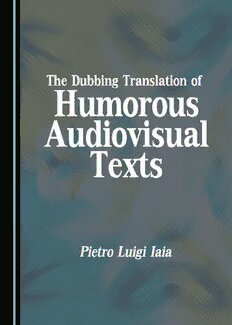
The Dubbing Translation of Humorous Audiovisual Texts PDF
Preview The Dubbing Translation of Humorous Audiovisual Texts
The Dubbing Translation of Humorous Audiovisual Texts The Dubbing Translation of Humorous Audiovisual Texts By Pietro Luigi Iaia The Dubbing Translation of Humorous Audiovisual Texts By Pietro Luigi Iaia This book first published 2015 Cambridge Scholars Publishing Lady Stephenson Library, Newcastle upon Tyne, NE6 2PA, UK British Library Cataloguing in Publication Data A catalogue record for this book is available from the British Library Copyright © 2015 by Pietro Luigi Iaia All rights for this book reserved. No part of this book may be reproduced, stored in a retrieval system, or transmitted, in any form or by any means, electronic, mechanical, photocopying, recording or otherwise, without the prior permission of the copyright owner. ISBN (10): 1-4438-8038-8 ISBN (13): 978-1-4438-8038-1 TABLE OF CONTENTS List of Figures............................................................................................. ix Introduction ................................................................................................. 1 Investigating Audiovisual Translation 1. Book Rationale and Objectives 2. The Chapters Chapter One ................................................................................................. 9 Audiovisual Translation: History and Central Issues 1.1 The Introduction of Dubbing in Italy 1.2 The Language of Dubbing: Dubbese 1.3 Technical Issues of Dubbing 1.4 Game Localisation 1.4.1 Transcreation 1.5 Equivalence in Audiovisual Translation 1.5.1 Pragmalinguistic Equivalence in Audiovisual Translation 1.5.2 Implicature and Presupposition 1.6 Conclusions Chapter Two .............................................................................................. 33 The Grounds of Audiovisual Representation 2.1 The Grammar of Audiovisual Texts 2.2 Multimodality: The Role of Images and Acoustic Scores 2.3 Conclusions Chapter Three ............................................................................................ 49 The Production and Translation of Humorous Discourse 3.1 The Production of Humorous Discourse: Cognitive, Socio-cultural and Linguistic Dimensions 3.2 The Translation of Humorous Discourse 3.3 Conclusions vi Table of Contents Chapter Four .............................................................................................. 61 The Interactive Model, Method and Corpus 4.1 The Interactive Model: Rationale and Objectives 4.2 The Interactive Model: Mediated-Cognitive Semantic Representation 4.2.1 Levels of Analysis and the Translator’s Competences 4.3 Phases of the Model: “MuCrAS” and “MuReTS” 4.3.1 A Practical Application of the Interactive Model 4.4 Method and Corpus 4.4.1 Corpus 4.5 Conclusions Chapter Five .............................................................................................. 79 Analysis of Films and TV Series 5.1 The Adoption of Diatopic/Diastratic Varieties in Films and TV Series 5.1.1 The Neapolitan Diatopic/Diastratic Variety 5.1.2 The Sicilian Diatopic/Diastratic Variety 5.1.3 The Calabrese Diatopic/Diastratic Variety 5.1.4 The Barese Diatopic/Diastratic Variety 5.1.5 Other Diatopic/Diastratic Varieties 5.2 Pragmalinguistic Misrepresentations in Films and TV Series 5.3 Different Translation Strategies in Films and TV Series 5.4 Conclusions Chapter Six .............................................................................................. 125 Analysis of Video-game Scripts 6.1 The Adoption of Diatopic/Diastratic Varieties in Video-game Scripts 6.1.1 Final Fantasy IX 6.1.2 Mario & Luigi: Bowser’s Inside Story and Super Paper Mario 6.2 Pragmalinguistic Misrepresentations in Video-game Scripts 6.3 Different Translation Strategies in Video-game Scripts 6.4 Conclusions The Dubbing Translation of Humorous Audiovisual Texts vii Chapter Seven .......................................................................................... 155 Alternative Translations and Audience Reception 7.1 Alternative Translation from Family Guy 7.2 Alternative Translations from Looking for Alibrandi 7.3 Alternative Translations from Conan 7.4 Alternative Translations from Lollipop Chainsaw 7.5 Alternative Translation from Ni No Kuni: Wrath of the White Witch 7.6 Alternative Translation from Final Fantasy IX and Questionnaire on Audience Reception 7.6.1 Alternative Translation of Interaction (41) 7.6.2 Questionnaire on Audience Reception 7.7 Conclusions Chapter Eight ........................................................................................... 189 Conclusions 8.1 Audiovisual Translation as a Communicative and Interpretative Process 8.2 The Interactive Model: Characteristics and Objectives 8.3 The Interactive Model: Pedagogic Applications 8.4 Research Objectives and Results 8.5 Research Prospects Appendix A ............................................................................................. 197 Other Extracts Appendix B .............................................................................................. 203 Questionnaire on Audience Reception References ............................................................................................... 209 1. Bibliography 2. Websites 3. Audiovisual Texts Notes ........................................................................................................ 223 LIST OF FIGURES 2-1 Sheldon “Reacter” in “The Big Bran Hypothesis”, from The Big Bang Theory ......................................................................................... 40 2-2 Sheldon “Actor” and “Process” in “The Big Bran Hypothesis”, from The Big Bang Theory .................................................................. 41 2-3 “Demand Image”, from Kandahar ...................................................... 42 2-4 “Offer Image”, from Kandahar ........................................................... 43 2-5 Penny “Theme” and Leonard “Rheme”, in “The Big Bran Hypotheses”, from The Big Bang Theory ............................................ 44 4-1 Phases of the Interactive Model and a description of their objectives ... 68 4-2 Levels of the “MuCrAS” Phase ........................................................... 69 4-3 Levels of the “MuReTS” Phase ........................................................... 70 4-4 Schematic Representation of the Interactive Model ............................ 71 7-1 Levels of humorous effect in the original script ................................ 183 7-2 Levels of equivalence of the official translation ............................... 183 7-3 Levels of humorous effect in the official translation ......................... 184 7-4 Levels of equivalence of the alternative translation .......................... 185 7-5 Levels of humorous effect in the alternative translation ................... 185
